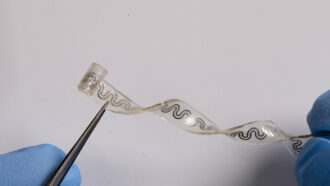
A flexible electronic implant could one day make pain management a lot more chill.
Created from materials that dissolve in the body, the device encircles nerves with an evaporative cooler. Implanted in rats, the cooler blocked pain signals from zipping up to the brain, bioengineer John Rogers and colleagues report in the July 1 Science.
Though far from ready for human use, a future version could potentially let “patients dial up or down the pain relief they need at any given moment,” says Rogers, of Northwestern University in Evanston, Ill.
Scientists already knew that low temperatures can numb nerves in the body. Think of frozen fingers in the winter, Rogers says. But mimicking this phenomenon with an electronic implant isn’t easy. Nerves are fragile, so scientists need something that gently hugs the tissues. And an ideal implant would be absorbed by the body, so doctors wouldn’t have to remove it.
Made from water-soluble materials, the team’s device features a soft cuff that wraps around a nerve like toilet paper on a roll. Tiny channels snake down its rubbery length. When liquid coolant that’s pumped through the channels evaporates, the process draws heat from the underlying nerve. A temperature sensor helps scientists hit the sweet spot — cold enough to block pain but not too cold to damage the nerve.
The researchers wrapped the implant around a nerve in rats and tested how they responded to having a paw poked. With the nerve cooler switched on, scientists could apply about seven times as much pressure as usual before the animals pulled their paws away. That’s a sign that the rats’ senses had grown sluggish, Rogers says.
He envisions the device being used to treat pain after surgery, rather than chronic pain. The cooler connects to an outside power source and would be tethered to patients like an IV line. They could control the level of pain relief by adjusting the coolant’s flow rate. Such a system might offer targeted relief without the downsides of addictive pain medications like opioids, Rogers suggests (SN: 8/27/19).
Now the researchers want to explore how long they can apply the cooling effect without damaging tissues, Rogers says. In experiments, the longest that they cooled rats’ nerves was for about 15 minutes.
“If treating pain, cooling would have to go on for a much longer period of time,” says Seward Rutkove, a nerve physiologist at Harvard Medical School who wasn’t involved in the study. Still, he adds, the device is “an interesting proof of concept and should definitely be pursued.”

 A new treatment could restore some mobility in people paralyzed by strokes
A new treatment could restore some mobility in people paralyzed by strokes  What has Perseverance found in two years on Mars?
What has Perseverance found in two years on Mars?  This robot automatically tucks its limbs to squeeze through spaces
This robot automatically tucks its limbs to squeeze through spaces  Greta Thunberg’s new book urges the world to take climate action now
Greta Thunberg’s new book urges the world to take climate action now  Glassy eyes may help young crustaceans hide from predators in plain sight
Glassy eyes may help young crustaceans hide from predators in plain sight  A chemical imbalance doesn’t explain depression. So what does?
A chemical imbalance doesn’t explain depression. So what does?